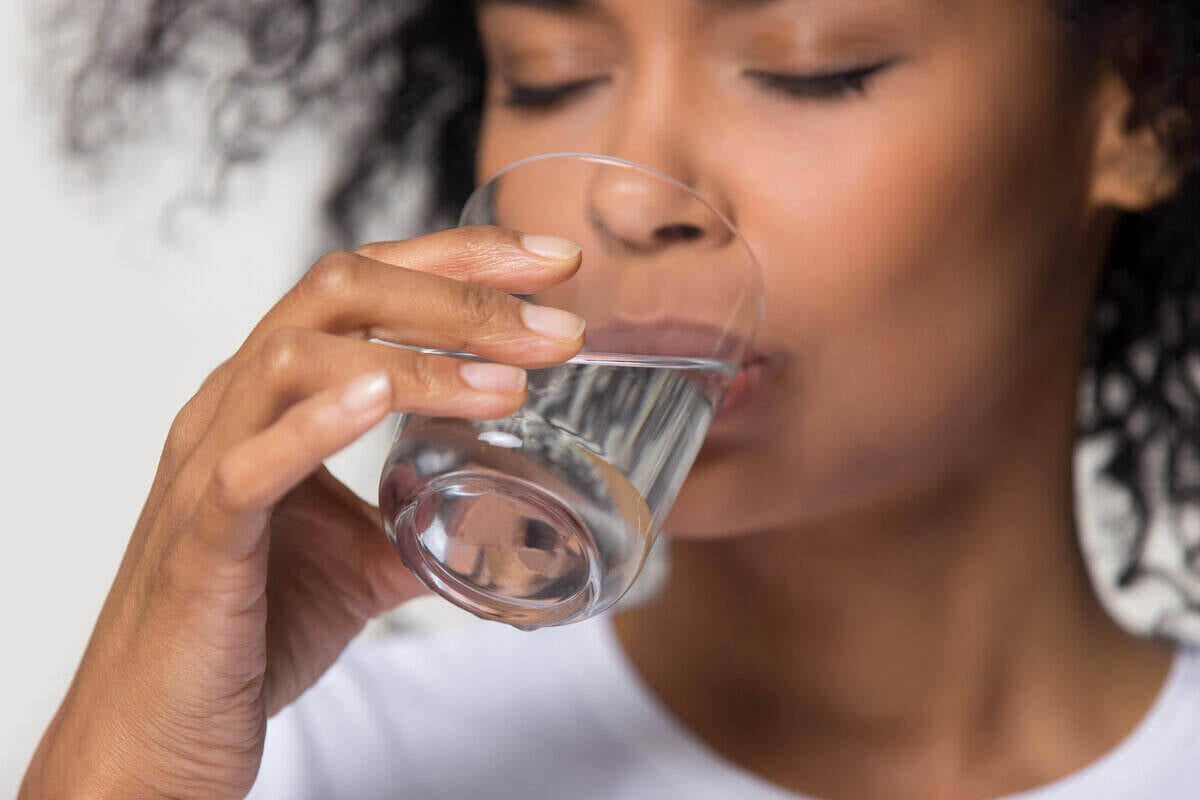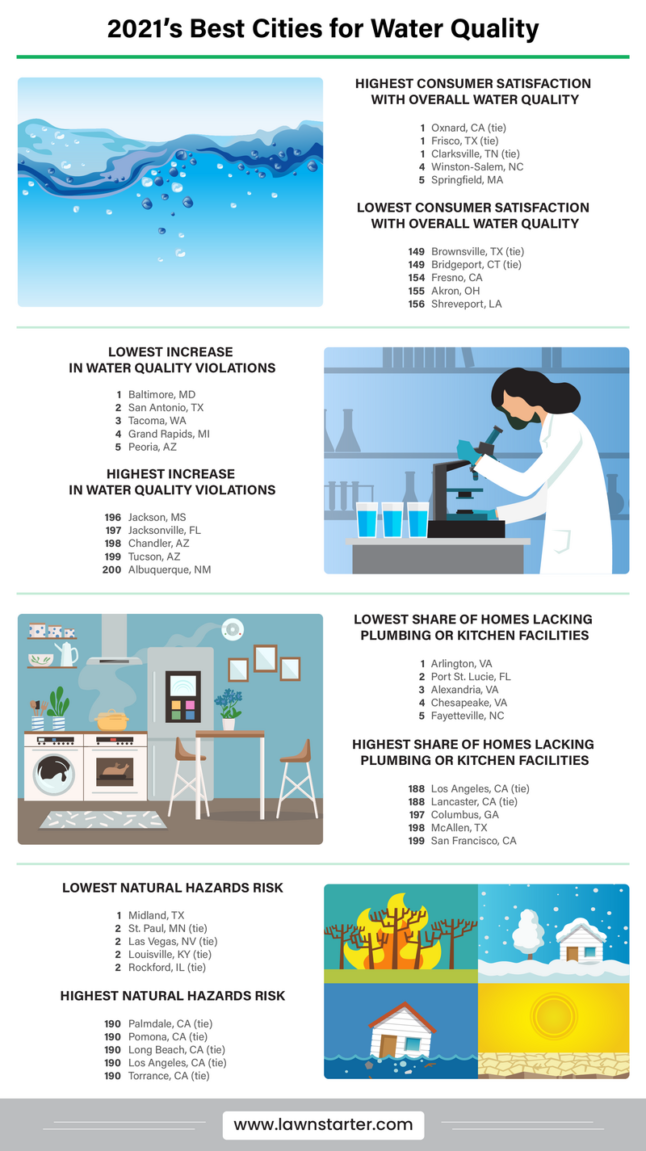
CORRECTION: LawnStarter discovered an error in the formula used to calculate the rankings for our Best Cities for Water Quality report and updated the city rankings, highlights and lowlights, and the methodology sections of this report on April 1.
What does it take to live a good life? Happiness, liberty, and water.
Humans can last up to 21 days without food but barely make it to Day 3 without H2O. That’s because our bodies are made up of up to 75% water. Our food supply, schools, homes, and businesses also depend on a fresh supply of this life-giving liquid.
But water quality varies across America’s cities. Do you know how fresh your water comes out of the tap compared with other consumers’?
LawnStarter ranked the Best Cities for Water Quality by comparing the 200 biggest U.S. cities based on seven key factors — from consumers’ overall satisfaction with their water to the number of water quality violations to the share of homes lacking basic plumbing.
Check out our ranking below, followed by some highlights, lowlights, and expert insights.
Table of Contents
City Rankings
See how each city fared in our ranking:
| OVERALL RANK | City | Overall Score | Consumer Satisfaction Rank | Compliance Rank | Infrastructure Vulnerability Rank |
|---|---|---|---|---|---|
| 1 | Cary, NC | 88.339 | N/A | 157 | 2 |
| 2 | Winston-Salem, NC | 85.504 | 2 | 3 | 126 |
| 3 | Yonkers, NY | 84.902 | N/A | 157 | 26 |
| 4 | Bellevue, WA | 84.757 | 6 | 6 | 50 |
| 5 | Clarksville, TN | 84.611 | 11 | 20 | 16 |
| 6 | Arlington, VA | 84.395 | 18 | 17 | 8 |
| 7 | Murfreesboro, TN | 84.306 | N/A | 157 | 21 |
| 8 | Sioux Falls, SD | 83.985 | 19 | 18 | 3 |
| 9 | North Las Vegas, NV | 83.873 | N/A | 157 | 34 |
| 10 | Frisco, TX | 83.685 | 1 | 1 | 151 |
| 11 | Spokane, WA | 83.533 | 14 | 11 | 33 |
| 12 | Paterson, NJ | 83.479 | N/A | 157 | 59 |
| 13 | Grand Rapids, MI | 83.172 | 28 | 30 | 11 |
| 14 | Paradise, NV | 83.119 | N/A | 157 | 34 |
| 14 | Spring Valley, NV | 83.119 | N/A | 157 | 34 |
| 14 | Sunrise Manor, NV | 83.119 | N/A | 157 | 34 |
| 14 | Enterprise, NV | 83.119 | N/A | 157 | 34 |
| 18 | Midland, TX | 83.095 | N/A | 157 | 68 |
| 19 | Rancho Cucamonga, CA | 82.851 | 4 | 4 | 109 |
| 20 | Huntsville, AL | 82.754 | 20 | 19 | 20 |
| 21 | Laredo, TX | 82.728 | N/A | 157 | 69 |
| 22 | St. Paul, MN | 81.777 | 21 | 21 | 19 |
| 23 | Cape Coral, FL | 81.718 | N/A | 157 | 88 |
| 24 | Little Rock, AR | 81.517 | 12 | 10 | 104 |
| 25 | Springfield, MA | 81.297 | 8 | 13 | 130 |
| 26 | Salem, OR | 81.248 | 15 | 15 | 101 |
| 27 | Columbus, OH | 81.029 | 22 | 23 | 29 |
| 28 | St. Petersburg, FL | 80.526 | 27 | 26 | 10 |
| 29 | Aurora, CO | 79.975 | 16 | 8 | 96 |
| 30 | Boston, MA | 79.485 | 26 | 27 | 30 |
| 31 | Glendale, AZ | 79.238 | N/A | 157 | 61 |
| 32 | Dayton, OH | 79.127 | 42 | 43 | 7 |
| 33 | Thornton, CO | 78.589 | N/A | 157 | 100 |
| 34 | Overland Park, KS | 78.509 | 7 | 7 | 147 |
| 35 | Metairie, LA | 78.489 | N/A | 157 | 102 |
| 36 | Naperville, IL | 78.22 | 3 | 2 | 180 |
| 37 | Minneapolis, MN | 78.2 | 44 | 44 | 44 |
| 38 | Seattle, WA | 78.089 | 36 | 35 | 50 |
| 39 | San Bernardino, CA | 77.996 | N/A | 157 | 109 |
| 40 | Ontario, CA | 77.995 | N/A | 157 | 109 |
| 41 | Charlotte, NC | 77.763 | 33 | 36 | 25 |
| 42 | Moreno Valley, CA | 77.69 | N/A | 157 | 119 |
| 43 | Corona, CA | 77.667 | N/A | 157 | 119 |
| 44 | Hollywood, FL | 77.629 | N/A | 157 | 115 |
| 45 | Miramar, FL | 77.613 | N/A | 157 | 115 |
| 46 | McKinney, TX | 77.521 | 17 | 16 | 137 |
| 47 | Hialeah, FL | 77.495 | N/A | 157 | 106 |
| 48 | Pembroke Pines, FL | 77.348 | N/A | 157 | 115 |
| 49 | Peoria, AZ | 77.26 | 45 | 51 | 73 |
| 50 | Springfield, MO | 77.227 | 63 | 54 | 5 |
| 51 | Raleigh, NC | 77.1 | 30 | 28 | 13 |
| 52 | Fort Collins, CO | 77.086 | 34 | 29 | 89 |
| 52 | Omaha, NE | 77.086 | 46 | 46 | 78 |
| 54 | Gilbert, AZ | 77.039 | N/A | 157 | 61 |
| 55 | Lincoln, NE | 76.943 | 50 | 52 | 28 |
| 56 | Lexington, KY | 76.746 | 64 | 62 | 4 |
| 57 | Richmond, VA | 76.614 | 25 | 25 | 105 |
| 58 | Vancouver, WA | 76.538 | 41 | 45 | 79 |
| 59 | Eugene, OR | 76.513 | 37 | 32 | 92 |
| 60 | Tacoma, WA | 76.386 | 95 | 87 | 52 |
| 61 | Wichita, KS | 76.265 | 58 | 57 | 17 |
| 62 | Fremont, CA | 76.196 | 10 | 12 | 168 |
| 63 | Augusta, GA | 76.086 | 57 | 56 | 48 |
| 64 | Madison, WI | 75.653 | 47 | 41 | 32 |
| 65 | Portland, OR | 75.559 | 43 | 40 | 90 |
| 66 | Alexandria, VA | 75.492 | 54 | 47 | 74 |
| 67 | Arlington, TX | 75.449 | 13 | 14 | 172 |
| 68 | Nashville, TN | 75.436 | 85 | 80 | 12 |
| 69 | Louisville, KY | 75.377 | 52 | 49 | 77 |
| 70 | Olathe, KS | 75.17 | N/A | 157 | 147 |
| 71 | Boise City, ID | 75.111 | 31 | 34 | 80 |
| 72 | Colorado Springs, CO | 75.057 | 66 | 65 | 6 |
| 73 | Escondido, CA | 75.008 | N/A | 157 | 138 |
| 73 | Chula Vista, CA | 75.008 | N/A | 157 | 138 |
| 75 | Oceanside, CA | 75.005 | N/A | 157 | 138 |
| 76 | Elk Grove, CA | 74.997 | N/A | 157 | 142 |
| 77 | San Antonio, TX | 74.92 | 107 | 104 | 55 |
| 78 | Tulsa, OK | 74.673 | 67 | 64 | 47 |
| 79 | Atlanta, GA | 74.63 | 105 | 105 | 1 |
| 80 | Scottsdale, AZ | 74.466 | 55 | 61 | 61 |
| 81 | Lakewood, CO | 74.334 | N/A | 157 | 149 |
| 82 | Des Moines, IA | 74.199 | 76 | 79 | 24 |
| 83 | Chesapeake, VA | 73.882 | N/A | 157 | 131 |
| 84 | New York, NY | 70.543 | 100 | 102 | 72 |
| 84 | Mesquite, TX | 73.864 | N/A | 157 | 153 |
| 85 | Greensboro, NC | 73.731 | 53 | 53 | 97 |
| 86 | Anchorage, AK | 73.684 | 5 | 5 | N/A |
| 87 | Durham, NC | 73.643 | 40 | 37 | 57 |
| 88 | Garland, TX | 73.597 | N/A | 157 | 156 |
| 89 | Columbus, GA | 73.589 | 56 | 48 | 125 |
| 90 | Tampa, FL | 73.327 | 83 | 75 | 27 |
| 91 | Hayward, CA | 73.277 | 23 | 24 | 168 |
| 92 | Reno, NV | 73.253 | 29 | 33 | 174 |
| 93 | Birmingham, AL | 73.188 | 59 | 58 | 98 |
| 94 | Milwaukee, WI | 73.135 | 73 | 69 | 86 |
| 95 | Pasadena, TX | 73.074 | N/A | 157 | 163 |
| 96 | Pasadena, CA | 73.013 | 9 | 9 | 191 |
| 97 | Rochester, NY | 72.954 | 96 | 90 | 53 |
| 98 | Irving, TX | 72.876 | N/A | 157 | 164 |
| 99 | Baton Rouge, LA | 72.7 | 72 | 70 | 93 |
| 100 | Henderson, NV | 72.685 | 99 | 111 | 34 |
| 101 | Grand Prairie, TX | 72.632 | N/A | 157 | 166 |
| 102 | Salt Lake City, UT | 72.572 | 70 | 67 | 94 |
| 103 | Fort Wayne, IN | 72.443 | 98 | 101 | 15 |
| 104 | Honolulu, HI | 72.439 | 69 | 68 | 123 |
| 105 | Oxnard, CA | 72.413 | 49 | 84 | 162 |
| 106 | Killeen, TX | 72.338 | N/A | 157 | 167 |
| 107 | St. Louis, MO | 72.105 | 65 | 66 | 122 |
| 108 | Lubbock, TX | 72.098 | 87 | 97 | 75 |
| 109 | Cincinnati, OH | 71.996 | 75 | 73 | 95 |
| 110 | Buffalo, NY | 71.941 | 24 | 22 | 173 |
| 111 | Tallahassee, FL | 71.516 | 82 | 82 | 83 |
| 112 | Oakland, CA | 71.283 | 38 | 39 | 168 |
| 113 | Austin, TX | 71.084 | 81 | 78 | 84 |
| 114 | Tempe, AZ | 70.787 | 104 | 103 | 61 |
| 115 | Santa Rosa, CA | 70.707 | 79 | 89 | 132 |
| 116 | Garden Grove, CA | 70.644 | N/A | 157 | 176 |
| 118 | Mesa, AZ | 70.539 | 117 | 125 | 61 |
| 119 | Denver, CO | 70.494 | 48 | 50 | 135 |
| 120 | Virginia Beach, VA | 70.113 | 60 | 55 | 136 |
| 121 | Syracuse, NY | 69.966 | 118 | 116 | 14 |
| 122 | Kansas City, MO | 69.798 | 84 | 76 | 133 |
| 123 | Miami, FL | 69.525 | 97 | 94 | 106 |
| 124 | Baltimore, MD | 69.277 | 134 | 134 | 82 |
| 125 | Worcester, MA | 69.247 | 111 | 93 | 71 |
| 126 | Plano, TX | 69.084 | 74 | 81 | 151 |
| 127 | Oklahoma City, OK | 69.054 | 39 | 42 | 182 |
| 128 | Cleveland, OH | 68.884 | 93 | 85 | 129 |
| 129 | Knoxville, TN | 68.852 | 121 | 123 | 18 |
| 130 | Fort Lauderdale, FL | 68.667 | 102 | 109 | 115 |
| 131 | McAllen, TX | 68.651 | 90 | 96 | 161 |
| 131 | Montgomery, AL | 68.651 | 120 | 119 | 23 |
| 133 | Orlando, FL | 68.578 | 116 | 115 | 31 |
| 134 | Sacramento, CA | 68.561 | 88 | 88 | 142 |
| 135 | Long Beach, CA | 68.456 | 32 | 31 | 191 |
| 136 | Dallas, TX | 68.38 | 78 | 77 | 155 |
| 137 | Washington, DC | 68.378 | 106 | 106 | 113 |
| 138 | Las Vegas, NV | 68.373 | 130 | 131 | 34 |
| 139 | Mobile, AL | 68.313 | 94 | 86 | 145 |
| 140 | El Paso, TX | 68.155 | 122 | 127 | 9 |
| 141 | Port St. Lucie, FL | 68.139 | 124 | 120 | 70 |
| 142 | Joliet, IL | 68.13 | N/A | 157 | 181 |
| 143 | Santa Clarita, CA | 68.107 | 35 | 38 | 191 |
| 144 | Orange, CA | 67.768 | N/A | 157 | 185 |
| 145 | Fullerton, CA | 67.764 | N/A | 157 | 185 |
| 146 | Philadelphia, PA | 67.744 | 113 | 112 | 103 |
| 147 | Fontana, CA | 67.64 | 112 | 121 | 109 |
| 148 | Aurora, IL | 67.413 | 51 | 60 | 183 |
| 149 | San Jose, CA | 67.405 | 91 | 95 | 157 |
| 150 | Jackson, MS | 67.289 | 80 | 91 | 127 |
| 151 | Memphis, TN | 67.111 | 77 | 71 | 171 |
| 152 | Pomona, CA | 66.702 | N/A | 157 | 191 |
| 153 | Lancaster, CA | 66.688 | N/A | 157 | 191 |
| 154 | Irvine, CA | 66.47 | 61 | 63 | 185 |
| 155 | Chattanooga, TN | 66.243 | 123 | 122 | 91 |
| 156 | Torrance, CA | 66.224 | N/A | 157 | 191 |
| 157 | Anaheim, CA | 65.807 | 89 | 98 | 176 |
| 158 | Providence, RI | 65.645 | 137 | 135 | 56 |
| 159 | Phoenix, AZ | 65.559 | 129 | 132 | 61 |
| 160 | Savannah, GA | 65.555 | 101 | 100 | 160 |
| 161 | Chandler, AZ | 65.484 | 108 | 110 | 61 |
| 162 | Kansas City, KS | 65.372 | 68 | 74 | 189 |
| 163 | Indianapolis, IN | 65.307 | 114 | 113 | 76 |
| 164 | Sunnyvale, CA | 65.112 | 110 | 108 | 157 |
| 165 | Amarillo, TX | 64.815 | 135 | 137 | 45 |
| 166 | San Diego, CA | 64.657 | 119 | 117 | 138 |
| 167 | Riverside, CA | 64.435 | 133 | 133 | 119 |
| 168 | Modesto, CA | 64.285 | 128 | 130 | 128 |
| 169 | Glendale, CA | 63.565 | 86 | 83 | 191 |
| 170 | Macon, GA | 63.431 | 139 | 140 | 58 |
| 171 | Houston, TX | 63.181 | 127 | 126 | 150 |
| 172 | San Francisco, CA | 62.945 | 92 | 92 | 190 |
| 173 | Rockford, IL | 62.752 | 142 | 142 | 22 |
| 174 | Salinas, CA | 62.687 | 135 | 137 | 114 |
| 175 | Detroit, MI | 62.641 | 115 | 114 | 179 |
| 176 | Norfolk, VA | 62.598 | 132 | 124 | 146 |
| 177 | Santa Ana, CA | 62.351 | 103 | 99 | 185 |
| 178 | Pittsburgh, PA | 61.729 | 131 | 129 | 159 |
| 179 | Chicago, IL | 61.417 | 109 | 107 | 184 |
| 180 | Huntington Beach, CA | 61.199 | 125 | 118 | 176 |
| 181 | Jacksonville, FL | 61.071 | 140 | 139 | 41 |
| 182 | Fort Worth, TX | 61.033 | 126 | 128 | 175 |
| 183 | New Orleans, LA | 59.877 | 147 | 147 | 99 |
| 184 | Fayetteville, NC | 59.56 | 148 | 148 | 46 |
| 185 | Newark, NJ | 59.39 | 146 | 145 | 87 |
| 186 | Newport News, VA | 59.018 | 143 | 143 | 144 |
| 187 | Jersey City, NJ | 58.654 | 145 | 146 | 134 |
| 188 | Brownsville, TX | 58.14 | 149 | 149 | 81 |
| 189 | Bakersfield, CA | 58.079 | 144 | 141 | 154 |
| 190 | Corpus Christi, TX | 57.682 | 151 | 151 | 49 |
| 191 | Toledo, OH | 57.037 | 152 | 152 | 42 |
| 192 | Stockton, CA | 56.512 | 150 | 150 | 124 |
| 193 | Los Angeles, CA | 55.621 | 138 | 136 | 191 |
| 194 | Tucson, AZ | 55.424 | 71 | 72 | 60 |
| 195 | Palmdale, CA | 54.674 | 141 | 144 | 191 |
| 196 | Albuquerque, NM | 54.593 | 62 | 59 | 54 |
| 197 | Akron, OH | 53.459 | 154 | 154 | 108 |
| 198 | Shreveport, LA | 50.372 | 156 | 155 | 85 |
| 199 | Fresno, CA | 50.192 | 153 | 153 | 165 |
| 200 | Bridgeport, CT | 49.601 | 155 | 156 | 43 |

Highlights and Lowlights
Crisp and Clear in North Carolina
While some Tar Heel cities rank middle-of-the-pack on water quality, two landed in the top spots on our list.
North Carolina also boasts some of the most improved cities with large decreases in water quality violations between 2015 and 2020.
It’s no wonder the state has improved so drastically — in 2018 North Carolina embarked on an aggressive water quality testing and improvement program. Clearly the state’s efforts have paid off, and the water is crisper and clearer in North Carolina.
Bigger Isn’t Always Better
Some of America’s biggest cities — including Detroit, Pittsburgh, Chicago, and Los Angeles — share one thing in common: They’re among the bottom 30 cities in our water quality ranking.
What’s dragging down these cities on water quality? They all performed poorly on infrastructure vulnerability — with the exception of New Orleans (just slightly above average).
Their lackluster performance also tracks with a trend uncovered by the U.S. Government Accountability Office: In recent years, the largest U.S. cities have experienced a population decline, resulting in fewer taxpayers to pay for water infrastructure improvements, maintenance, and repairs.
Clearly, going big comes with a price — but change may be a comin’, considering the Biden administration’s $111 billion proposed plan to improve America’s water infrastructure systems.
Water in the Desert — or Not
Despite ranking middle of the pack on consumer satisfaction, Arizona cities consistently have some of the highest numbers of water quality violations in the country. Tucson takes the bottom spot in this category with tens of thousands of historical violations as of Q4 2020. Cities like Chandler and Peoria aren’t far behind with many thousands of violations.
What’s behind this bad water in the Grand Canyon State? With a growing population, a draining aquifer, a booming agriculture industry, and competition from neighboring states, to say that the water system in Arizona is stressed would be an understatement. Here’s hoping they can catch a break — and a drink.
The Last Frontier … for Water Quality
Anchorage, Alaska, boasts the 12th highest overall consumer satisfaction and fifth highest satisfaction with water quality and accessibility. Clearly, Anchorage residents love their water system.
But there’s one problem: Anchorage has the second highest number of historical water quality violations in the country, as of Q4 2020. These recent quality issues are spread throughout Alaska as a historic drought takes its toll.
So where do the positive satisfaction ratings come from? The answer isn’t clear. Perhaps the residents of Anchorage are just a very understanding people.
Ask The Experts
Both the federal government and most state governments set quality standards for America’s drinking water. But Americans have a role to play in ensuring that those standards are upheld. We reached out to a panel of experts for answers to the most pressing questions on this topic. See what they had to say below.
- Are water pitcher and faucet filters like those made by Brita and Pur necessary or just marketing scams? Please explain.
-
Who needs a water softener in their home?
-
How can consumers determine if their local drinking water is unsafe or if public water standards have been violated?
- What is the best way for consumers to get involved in protecting the quality of their local drinking water?
-
Unregulated private wells supply water to 15 million U.S. households, but at least 20% are contaminated, according to federal government agencies. Should private wells be regulated? Why or why not?
Check out their answers below..










Are water pitcher and faucet filters like those made by Brita and Pur necessary or just marketing scams? Please explain.
It depends on the source of their drinking water. For instance, in Arkansas like many other states, municipal water sources must meet minimum drinking water standards, and in Arkansas, these municipal sources must provide an annual water quality report.
I personally am on a municipal source and drink the tap water. For some people on municipal water, the water may be safe to drink but may have an offensive odor or taste. For that reason, they want to use a filter but should get their water tested to see if the desired filter will solve their problem.
For people on private wells, they should also get their water tested and may desire to match a water filter to make their drinking water safer.
Who needs a water softener in their home?
Typically in Arkansas, well owners may want a water softener if they get their well tested and hardness is greater than 50 mg/L of CaCO3 equivalent. Those on city water may want to get softeners if they see signs of hard water such as filmy feel on their skin after bathing in hard water or spots on dishes, etc.
How can consumers determine if their local drinking water is unsafe or if public water standards have been violated?
In Arkansas, municipal or public water sources must provide an annual report to their customers. One could also contact their local health department or the state environmental agency.
What is the best way for consumers to get involved in protecting the quality of their local drinking water?
Joining a local watershed organization is a great way to get involved in protecting water quality.
Another way to build knowledge on protecting water quality is contacting their local county extension office, which can provide such information. For example, in Arkansas, we have the Arkansas Watershed Stewards Program and educational program for concerned citizens.
Unregulated private wells supply water to 15 million U.S. households, but at least 20% are contaminated, according to federal government agencies. Should private wells be regulated? Why or why not?
As I am not a regulator but rather an educator, I cannot comment, but I do recommend that private well owners get their wells tested periodically to ensure water quality and safety.
Well water testing can provide information on the type of filter or treatment system that is needed to ensure safety.

Are water pitcher and faucet filters like those made by Brita and Pur necessary or just marketing scams? Please explain.
The number of drinking water violations are growing across the country as utilities are financially strapped and are unable to meet standards.
These kinds of filters are able to remove some of the things that lead to taste and odor problems. They may not be able to remove lead, arsenic, PFAS, and other contaminants that are a more serious concern.
Who needs a water softener in their home?
Someone with hard water — typically highly mineralized ground water.
How can consumers determine if their local drinking water is unsafe or if public water standards have been violated?
The EPA has an ECHO database, and an organization called EWG.org makes it accessible on their website.
What is the best way for consumers to get involved in protecting the quality of their local drinking water?
Advocacy groups. Contacts with a state environmental quality or protection agency. Awareness of major industrial and farming operations and what they may be doing to the water, especially groundwater.
Unregulated private wells supply water to 15 million U.S. households, but at least 20% are contaminated, according to federal government agencies. Should private wells be regulated? Why or why not?
Often, these are in rural settings and the users may not have another alternative. If more than 15 families are supplied, then they have to register as a water utility in Texas and are regulated. Probably similar rules exist in other states. They should definitely be tested and monitored by their users.
The question with regulation would be what alternative supply could be made available to these people, and who pays for the infrastructure? Overall, water and wastewater infrastructure has seen the least investment per capita of all forms of infrastructure from the federal government since the 1980s, and this is the problem that needs to be addressed. Otherwise, regulation would just add additional costs to the population and may not solve the problems.
At the same time, we need to rethink our strategy for infrastructure, so smaller, decentralized systems become the norm, and lower costs are achieved by manufacturing large numbers of high-quality but small treatment systems that could also convert wastewater to usable water. This would lower the investment needed and make water availability and management more local — the systems could still be managed by a single entity, but one would avoid the large pipe networks and land needed for large treatment systems and the associated cost.
As the smaller systems develop, there would be a solution for the people on these local private wells as well, since they could get appropriate treatment capacity.

Who needs a water softener in their home?
It may be needed in cases that the water is naturally hard and might represent a nuisance. However, hard drinking water is not necessarily a health hazard.
How can consumers determine if their local drinking water is unsafe or if public water standards have been violated?
The Safe Drinking Water Act of 1974 and the 1986 and 1996 ensure the quality and safety of drinking water.
The U.S. Environmental Protection Agency (EPA) has the authority to regulate public water systems to protect public health (drinking water standards and drinking water testing methods). States can administer the drinking water regulations and certify water quality testing labs.
Regular samples from the water distribution system are tested before reaching your tap. Water quality results are summarized and sent regularly to state agencies for review. Often these results are available to the public.
What is the best way for consumers to get involved in protecting the quality of their local drinking water?
We all are responsible to protect the quality of our drinking water. In addition, we have to use water in a responsible manner to ensure a sustainable resource available for future generations.
Unregulated private wells supply water to 15 million U.S. households, but at least 20% are contaminated, according to federal government agencies. Should private wells be regulated? Why or why not?
Yes, all drinking water providers should be regulated. I believe that full access to safe drinking water for all people should be granted to ensure equity in water security.

Are water pitcher and faucet filters like those made by Brita and Pur necessary or just marketing scams? Please explain.
Water quality is different across the U.S., so the exposure to different contaminants varies. In part it depends on the source (for example, a private well or if you are getting your water from a private utility with water quality violations, or there are lead pipes in your home); the geology of the area (i.e., some areas are prone to having arsenic, fluoride, and other things); anthropogenic sources such as fertilizers, pesticides, etc. So drinking water directly from the tap can potentially expose you to contaminants depending on where you are.
That being said, the products you mention do work depending on the problem there is. These products are commonly known as point-of-use (POU) systems but they have a wide range of the contaminants they remove.
Pitcher filters mainly have activated carbon to remove things like odors, taste, chlorine, and some metals depending on the product, but will not kill bacteria, viruses nor remove other nocive compounds. Under-the-sink filters that have finer membranes (such as microfiltration, nano filtration, or reverse osmosis) or UV disinfection remove all the contaminants of concern.
Quality across products varies and you can look at a recent study here that looks into the removal efficiency of different POUs.
Who needs a water softener in their home?
People for which the source water has large concentrations of calcium and magnesium (what is called “hard water”). It is not necessarily a health hazard, but it can reduce pipe flows, and soap doesn’t work too well. I believe some people also feel itchy.
I grew up at a place that has hard water, and we had to continuously clean the blocked shower heads, and when we boiled water it would always leave a film, but we never got a softener.
How can consumers determine if their local drinking water is unsafe or if public water standards have been violated
In the U.S., regulated utilities need to report water quality violations in the EPA’s SDWIS system. There you can look for a specific utility and see all the types of violations they have incurred. The most important ones for consumers would be the exceedances of maximum contaminant loads (MCL) because other violations may refer to paperwork they didn’t submit and other things are unrelated to health.
They can also reach out to their local water utility and ask for information, but this is not always an easy process. If they fear that they may be exposed to lead, some utilities offer lead testing kits (NYC’s DEP for example). For people with private wells, they must take water samples periodically and take them to a lab for analysis.
What is the best way for consumers to get involved in protecting the quality of their local drinking water
I would say to first get familiar with what are the potential sources of pollution in the area and how they are linked to their daily activities. For example, if nitrates and eutrophication are an issue like in Long Island Sound and if people have septic tanks, they need to do the necessary inspections to ensure the tanks are not leaking.
Following guidelines of what not to throw in the sink or toilet. Actively engaging with their water utilities so that water quality information is easily accessible and understandable. And well, depending on the context, join groups of activists to hold large polluters accountable and clean up waterways as Riverkeeper has been doing for years.
Unregulated private wells supply water to 15 million U.S. households, but at least 20% are contaminated, according to federal government agencies. Should private wells be regulated? Why or why not?
I don’t know if regulating them is the answer, but certainly they should be monitored. Point-of-use systems should be made available to protect people who are exposed to contaminants and, depending on the socioeconomic context, provide different financing options.
Perhaps you will find this recent article from The Guardian interesting.

Are water pitcher and faucet filters like those made by Brita and Pur necessary or just marketing scams? Please explain.
Sometimes they might help with taste problems. Local water utility experts should be able to give good local advice on this.
Who needs a water softener in their home?
If the water is very hard, these can be useful for laundry and plumbing problems. They add a lot of salts to wastewater, which can be a problem for wastewater disposal and downstream water uses.
How can consumers determine if their local drinking water is unsafe or if public water standards have been violated?
Each public water utility and state inspecting agency should have such information readily available.
What is the best way for consumers to get involved in protecting the quality of their local drinking water?
Talk to your local water utility and local public health authority. In some areas with particular problems, particularly rural areas, there are advocacy groups that can be useful.
Unregulated private wells supply water to 15 million U.S. households, but at least 20% are contaminated, according to federal government agencies. Should private wells be regulated? Why or why not?
My impression is that there is good reason for states to consider requiring testing (and perhaps reporting) of wells for locally problematic water quality problems upon the sale of properties.

Are water pitcher and faucet filters like those made by Brita and Pur necessary or just marketing scams? Please explain.
Water pitcher and faucet filters are often not necessary from a health perspective. What I mean by this is that public water supplies — meaning you pay a water bill — are strictly regulated by the Safe Drinking Water Act.
In these cases, filters can help with the taste and color of the water. They are not meant to make unsafe water safe to drink. If your water comes from a public supply, then by law, the water district must provide you with an annual report of water quality (see examples for San Francisco, California, and Austin, Texas).
Who needs a water softener in their home?
Water softeners are needed when someone has hard water, meaning water with a lot of mineral content. The high mineral content can cause scale buildup, particularly in water heaters, coffee pots, anything that boils water. Again, if the water supply is public, then it has to be safe to drink, so a softener is really about extending the life of your plumbing fixtures.
Water softeners also help when using water to clean, such as with washing machines or taking a bath (less soap is needed when the water is soft). To be honest, I would check with your local water softener supplier to determine if a water softener would help with your personal water supply.
If you are on a private well, then you can have your water sampled to determine the hardness. This is an easy test and likely something a water softener supply company would do for free with an estimate.
Be sure to do the research yourself with results; don’t necessarily believe the salesperson. For example, do your neighbors have water softeners?
What is the best way for consumers to get involved in protecting the quality of their local drinking water?
The best way for consumers to get involved in protecting water quality is to not pollute in the first place. For example, if you change your oil, then dispose of the waste oil at an approved facility. Don’t throw trash on the ground, particularly in areas near natural streams. Don’t build or farm near a natural stream. Don’t destroy wetlands (aka swamps) for building or roads, as these areas are very effective at protecting and improving water quality. If you are a hunter, pick up any shells that might lead to lead contamination. Don’t drive off-road.
Don’t fertilize your lawns or use herbicides or pesticides. As this is likely your business, you may take issue with this statement, but the over-fertilization of lawns and agricultural fields is one of the leading causes of water pollution in the U.S. today. It seems everyone wants the perfect green lawn without weeds; this simply is a created desire and not a need. It often harms natural systems. Sediment and nutrient pollution can be easily minimized or eliminated with proper controls on private property.
Unregulated private wells supply water to 15 million U.S. households, but at least 20% are contaminated, according to federal government agencies. Should private wells be regulated? Why or why not?
I agree that some form of periodic testing should be implemented for private wells, but who is to pay for that, how is it to be enforced, should there be limits on how much water you can withdraw from the well?
Achieving some form of consensus on this issue would be very difficult. I think a start would be for random testing at the tap of private wells using a statistically based sampling plan. What I mean by that is for the health department to sample random wells within a single aquifer on a periodic basis. Perhaps wells located “downstream” of known contamination sites should be tested frequently.

Are water pitcher and faucet filters like those made by Brita and Pur necessary or just marketing scams? Please explain.
They are neither necessary nor a marketing scam. Those are not the only two choices. These filters are generally effective at removing most chemicals that might be in your water at low concentrations. In most cases, the risk posed by these chemicals is very, very low, but it is not zero.
So each person can decide if they think it is worth the money to “polish” their tap water or if they are comfortable drinking the tap water as is.
Who needs a water softener in their home?
Water hardness is a nuisance. It gunks up your coffee maker and your clothes iron.
If your tap water is hard, maybe you think it is worth the money to buy a home water softener. Or, maybe you are okay living with spots on your dishes. It is a matter of preference.
Hardness is not harmful to health, but it is a nuisance.
How can consumers determine if their local drinking water is unsafe or if public water standards have been violated?
Cities are required by law to send an annual report to their customers, reporting measured concentrations and reporting if any of the contaminants are above legal limits. You can also call your city’s water department to request that this report should be mailed to you.
What is the best way for consumers to get involved in protecting the quality of their local drinking water?
Learn where your water comes from. Does your city draw from a nearby river? From a lake? From groundwater?
If you know the source of your water, you can learn what threats it faces.
Unregulated private wells supply water to 15 million U.S. households, but at least 20% are contaminated, according to federal government agencies. Should private wells be regulated? Why or why not?
How would these be regulated? The government cannot pay somebody to go out to each individual’s private well and take measurements. And if the water is deemed “dangerous” by the government, do they have the authority to tell a private citizen “you must treat your own water”? So regulating private wells is a bad idea.
A good idea is to help private well owners learn how to test their water and, if necessary, how to treat their water.

As a preamble, drinking water physical and chemical characteristics vary widely throughout the U.S. and even within a given city/county like Los Angeles, depending on the water source. Source waters can be surface waters (reservoirs, lakes, rivers, desalted ocean water) or groundwater (from wells or springs). The mineral quality, taste and odors, hardness, etc. vary, but all public water suppliers are required to comply with state and federal (USEPA) drinking water standards. This includes the bacteriological requirements.
All public water suppliers are required by federal law to issue annually a “consumer confidence report” sometimes called a “water quality report,” which must delineate the source(s) and the treated water quality (average and range) for various parameters. (Some are mandatory to report and many agencies provide much more information on various parameters.) Violations of any of the standards, including bacteriological in the previous year, must be reported. This report must also be published on their website and delivered to each customer.
Are water pitcher and faucet filters like those made by Brita and Pur necessary or just marketing scams? Please explain.
Because of the variability in tastes and odors of waters delivered to customers, some people just don’t like the taste of the water (maybe has some iron in it) or the smell (they don’t like chlorine smell), and they may want to use a filter to remove it.
One of the problems with activated carbon filters (“activated charcoal”) is they do remove chlorine, which also provides opportunities for bacteria to multiply on the carbon particles and eventually wash out into the drinking water glass. Usually the bacteria are not pathogenic, so there is no health concern.
I personally don’t have one, never have; but some people like the way their water tastes. I think it’s a matter of choice. I don’t think it’s a scam as long as the marketing is presented fairly — the way I’ve stated it — not to make the water safe to drink but to make it better suit your particular flavor profile.
Who needs a water softener in their home?
It all depends on the hardness of the water. Hardness is caused by the presence of calcium and magnesium ions in the water (and a few others, but too small a concentration to worry about).
These are naturally occurring and the result of rainwater, which is acidic by nature, dissolving calcium and magnesium from the rocks. Calcium and magnesium are not harmful and are not regulated. They will react with soap causing a scum to form and will waste soap (no “lather”); also will form a calcium carbonate scale in pipes, cooking pans from boiling water, and water heaters; and also makes the clothes “stiff” after washing, etc.
There are two types of water softeners: on-site regenerated and off-site regenerated.
The on-site are operated by the owners and use rock salt to regenerate an ion exchange resin (IX); the regenerating salt is then discharged into the sewer or septic tank (if no sewer). Some agencies have limitations on the sodium and chloride (minerals in rock salt), so they have ordinances banning on-site regenerated softeners; the salt makes the water less usable for recycling and may cause problems in the septic tank leach fields depending on the native soil types (sand vs. a sandy clay).
The off-site regeneration is done by collecting the IX resin cylinders and exchanging them for “fresh” ones and taking the spent cylinders to the “shop” for regeneration. The IX resin is saturated with a brine (salt) solution, and the sodium ions exchange from the liquid brine onto the IX resin. The IX resin and the water softener is returned to service and when either calcium or magnesium flow through the exchanger resin, two sodiums “jump off” and one calcium or magnesium ion “jumps on” to the resin. This means that softened water has a much higher sodium concentration than the “tap” water. People with low-sodium diets should not drink softened water. When the IX resin is exhausted, it needs to be regenerated; if not, nothing happens.
You can tell if you have soft water if you take a shower and your skin feels very slippery, like I can’t get the soap off.
How can consumers determine if their local drinking water is unsafe or if public water standards have been violated?
By the consumer confidence report or water quality report, as discussed above. It’s Important to understand just because the water has a funny taste or smell (usually from algal metabolites) doesn’t make the water unsafe or not meet standards. You may not want to drink it, but that doesn’t mean you can’t drink it.
What is the best way for consumers to get involved in protecting the quality of their local drinking water?
Protect the source.
If it’s groundwater, don’t dump toxins or extra waste medicines in the septic tank if they have one. Don’t dump used motor oil on the ground.
If it’s river or creek water going to a lake or reservoir, don’t put any pollutants on the ground that could wash into the creek or stream when it rains.
Unregulated private wells supply water to 15 million U.S. households, but at least 20% are contaminated, according to federal government agencies. Should private wells be regulated? Why or why not?
Assuming these are classified as public water systems or private wells serving schools and public facilities, regulation could pose a burden on individual homeowners. All well owners should inspect their wells. Bacteriological contamination (get sick right away) is usually due to contaminated water getting into the well from the surface of the ground. Make sure the well is firmly on a concrete pad and the top of the well pipe is above the ground sealed tight. Floods in rural areas can cause water to seep into wells making the well unusable until cleaned and disinfected.
Individual homeowners should have their well water tested periodically. If there is no evidence of surface contamination, probably every 5 to 10 years is okay. If the area has recently been flooded, I would have it tested ASAP before using unless the owner knows it is “tight.”
Well construction in many states is regulated; it is in California. A well driller must get a permit from the state or county health department and get it inspected as it is drilled. There are well standards, and one standard is called a “sanitary seal,” which is a cement grout poured around the well pipe (casing) from the ground surface to 40 or 50 feet below the ground surface to prevent any shallow surface contamination from intruding into the well.

Are water pitcher and faucet filters like those made by Brita and Pur necessary or just marketing scams? Please explain
How good a water filter is depends in part on what you want it to remove: dissolved substances or particulates, inorganics or organics, etc., as well as the level of contamination: mg/L, ug/L, or nanoparticles.
For instance, the EPA has evaluated the efficacy of some water pitchers and filters for use in homes that have lead contamination of their drinking water.
Who needs a water softener in their home?
Water softeners are usually an esthetic choice where the water is very hard. It is rarely “needed” in residential settings.
How can consumers determine if their local drinking water is unsafe or if public water standards have been violated?
Under the U.S. Safe Drinking Water Act, all public water systems (that is, systems providing water to 25 people for at least six months per year) must provide a Consumer Confidence Report to all of their customers, usually annually, with a description of their compliance with all of the federal drinking water requirements.
What is the best way for consumers to get involved in protecting the quality of their local drinking water?
On the local (municipal or county) level, customers can get involved in drinking water issues by going directly to the local public water supplier, through the local public health office, or by involvement in particular issues (e.g., testing lead levels in school drinking water, monitoring for PFOA/PFAS, etc.)
There are also often local environmental or neighborhood groups that are involved in specific drinking water issues.
Unregulated private wells supply water to 15 million U.S. households, but at least 20% are contaminated, according to federal government agencies. Should private wells be regulated? Why or why not?
Private wells are not covered under the U.S. Safe Drinking Water Act. They do not constitute public water systems and, therefore, cannot be regulated by the EPA.
Methodology
We ranked the 200 most populated U.S. cities in descending order — from best to worst — based on their overall scores, averaged across all the metrics listed below.
A rank of “N/A” in a particular category indicates lack of data for all metrics in that category. In such cases, the city’s overall score is its average across all metrics for which data were available.
The city that earned the highest overall score — out of a possible 100 points — ranked No. 1, or “best.”
Limitations:
- The U.S. Environmental Protection Agency requires local water suppliers to publish a water quality report every year by July 1. However, these reports are not available for every city or from every supplier on the EPA’s Consumer Confidence Reports (CCR) database. Absent this data and other official sources, LawnStarter relied instead on consumer satisfaction survey data from Numbeo as a substitute measure of quality.
- According to the EPA, its Safe Drinking Water Information System (SDWIS) database reports all historical water quality violations up to the most recent quarter. However, some data appears to be cleared out periodically, though the frequency and specific reasons for doing so are unclear. Results cannot be filtered to display only violations reported in a particular quarter.
| Metric | Weighting | Min. Value | Max. Value |
|---|---|---|---|
| Satisfaction with Overall Water Quality | 18.75 | 8.33 | 100 |
| Satisfaction with Drinking Water Quality and Accessibility | 18.75 | 25 | 100 |
| "Consumer Satisfaction" Category Total | 37.50 | ||
| Total Water Quality Violations | 12.50 | 0 | 56748 |
| Increase in Water Quality Violations | 18.75 | -896 | 3362 |
| "Compliance" Category Total | 31.25 | ||
| Share of Homes Lacking Plumbing or Kitchen Facilities | 12.50 | 0.31% | 4.34% |
| Share of Homes with Sewage Disposal Breakdowns in Last 3 Months | 12.50 | 0.51% | 1.97% |
| Natural Hazards Index Score | 6.25 | 9 | 20 |
| "Infrastructure Vulnerability" Category Total | 31.25 | ||
| Overall Total | 100.00 |
Sources: County Health Rankings & Roadmaps, National Center for Disaster Preparedness, Numbeo, U.S. Census Bureau, and U.S. Environmental Protection Agency
Why This Study Matters
We take for granted that the water coming out of our faucets is safe to drink, but that’s not always a safe bet.
Today, over 90% of the U.S. population has access to some of the safest drinking water in the world. That leaves millions of Americans with potentially unsafe water.
Over 15 million homes, for example, rely on unregulated private wells for their water supply. One federal agency found that about 1 in 5 private wells is contaminated — enough that it can lead to illness or even death.
That’s why during a pandemic, fresh, clean water has never been more important to warding off disease.
But the issue of America’s water crisis isn’t just about public health — it cuts across political, economic, environmental, and racial lines, as recent historical events have magnified.
The historic Texas winter storm in February 2021, for instance, left nearly 15 million residents without access to clean water, exposing the vulnerability of America’s water and wastewater systems to climate change.
As another example, the ongoing Flint, Michigan, water crisis — marking seven years in April 2021 — has led to the discovery that race is the leading indicator of access to clean water and violation of standards.
As consumers, it’s important to take an active role in ensuring the quality of our water — whether knowing what’s in it or holding our regulators accountable.
That starts with understanding which populations are most disadvantaged and vulnerable.
Main Photo Credit: Shutterstock